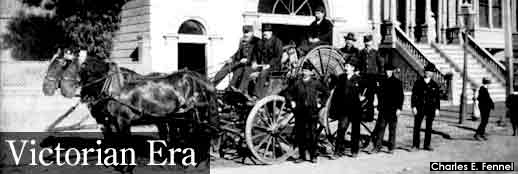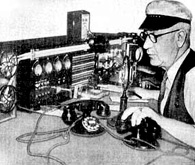| When
the alarm is first rung at the box, whether by crank or automatically,
a signal is sent to a Central Fire Alarm Station. When a box
is activated, a coded wheel starts to spin in its interior.
This wheel had notches etched into it that, when the wheel
begins to turn, run against a stationary finger. When the
notches knock against the finger, the electrical signal created
by the rotating wheel is interrupted, and at the central station,
a mark is placed on a moving piece of tape. The number of
notches corresponds to the box number. For example, box #267
located at Market and Beale would produce a code as follows:
-- ------ -------. Each alarm went through to the central
station four times.
Once
a station received the alarm indicating that station would
have to respond to a fire, the operator rang a bell to signal
the firefighters. As the alarm began to ring, the lights were
automatically turned on and the magnetic latches holding the
horses’ stalls closed were released. This, along with
a loud, piercing alarm, informed the firefighters of the fire
and where it was. Before the era of radios, firefighters had
to not only stay close to the fire station at all times, but
also had to live near to the fire station. Firemen either
lived at the fire station in bunks or lived within the surrounding
block so that every fireman was able to respond to every fire
alarm.
|



 Chester
Balliette
Chester
Balliette

